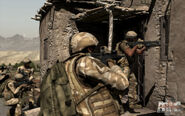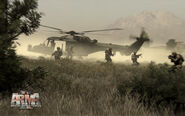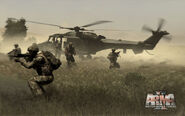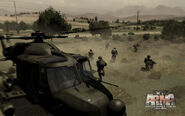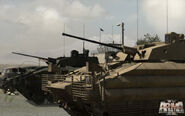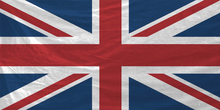
British Armed Forces flag
The British Armed Forces (alternately the British Army or simply BAF) is a BLUFOR faction in ArmA 2. It was added with the release of the British Armed Forces DLC.
Overview
| « | Utrinque Paratus (Ready For Anything) British paratroopers motto
|
» |
Background
Representing the armed forces of the United Kingdom, the British Army is one of the most technologically advanced factions in ArmA 2 alongside their American counterpart.
They are initially deployed as part of the joint NATO task force during the invasion of Takistan as part of Operation Arrowhead. Following the invasion and removal of its dictator Colonel Aziz, their role shifted to peacekeeping duties and training the New Takistani Army (NTA).
The contingent in Takistan comprises of several companies' worth of troopers from the 2nd Battalion, Parachute Regiment (2 PARA) that are involved in the on-going stabilisation efforts and counterinsurgency operations.
History
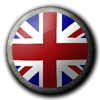
ArmA 2-era BAF emblem.
A few days after the ultimatum issued to the Takistani government passes, U.S.-led NATO forces initiate Operation Arrowhead.
Though they were not present in Zargabad in the final stages of the campaign, British forces helped to secure the western and southern parts of the country while the main bulkhead of U.S. Army forces took down the Colonel himself.
Events of Operation Arrowhead (2012)
Working alongside their Czech and German counterparts, the bulk of British Army ground troops and Special Air Service (SAS) teams were based in Karzeghistani territory prior to the main invasion. When the deadline expired on the eve of the invasion, Operation Arrowhead was given the green light from NATO command, and British forces from Task Force Rook and Task Force Queen crossed over the border into Takistani territory.
A combination of Royal Marines and a Fleet Air Arm (estimated squadron-sized) from the Royal Navy participated in the main assault against the southern cities of Karichar and Bandar-e-Ghazmi. British jets also sunk several Takistani naval gunboats and light cruisers alongside their American counterparts. A few SAS teams infiltrated and sabotaged key government facilities and military installations in both cities.
SAS teams later hunted down the last remnants of SCUD ballistic missile launchers that were primed at neighbouring Karzeghistan and the allied forces.
Events of Operation Crimson Lance (2012)
| SPOILER ALERT |
|---|
NOTE: This section contains spoilers from ArmA 2: British Armed Forces' 'Crimson Lance' campaign. 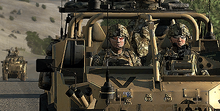 Counterinsurgency warfare becomes the main focus of British forces as they work to eliminate the last of the pro-Aziz groups in the country Operation Crimson Lance is in full effect as the British Army's strategic mission transitions into a counterinsurgency campaign in order to root out the remaining elements of the Takistani Army, still loyal to the (now deceased) Colonel Aziz. Notably amongst the British contingent in Takistan, Sergeant Brian Frost leads his squad (callsign Lancer Red) in an effort to restore stability and trust with the various villages and tribes scattered throughout the countryside. They defuse numerous Improvised Explosive Devices (IEDs) planted by the Takistani Army remnants, deliver humanitarian and medical aid supplies to Non-Government Organisations operating in the country, and provide security for other allied forces in the region.  British forces gear up for one last fight as they assault the main Takistani Army remnant base After being tipped off by intelligence sources, coalition forces eventually discover the main base being used by the Takistani Army remnants. In a joint raid with American forces and the local authorities, they assault the base and put an end to the last remnants of the insurgency with minimal casualties. |
Post-Operation Crimson Lance
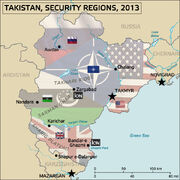
Post-invasion NATO deployment. British forces maintain security along the nation's southern border with Karzeghistan.
With the threat of the pro-Aziz Takistani Army remnants finally neutralised and the country's situation mostly under control, the British Army begins the withdrawal of all its combat forces out of the country.
A small force of non-combat personnel remain behind to assist the on-going stabilisation operations but mostly stay in the secure and safer green zones.
| « | Operation Crimson Lance was rough - I lost a lot of good lads and for no good reason. We were crying out for more airframes, more bloody tanks. Resources just weren't there - and as for the Yanks.. Brian Frost reminiscing bitterly post-Crimson Lance
|
» |
However, their pullout alongside other NATO forces in the region also sets the country's gradual slide into civil warfare yet again. Almost a year after the invasion's end, the various tribes of the country, no longer unconditionally supportive of the West, compete against the NTA for control of the country.
Disgusted with the turn of events and the sacrifices of his men being all for naught, Brian Frost applies to be discharged from the British Army and joins up with the ION Services private military company.
Events of The East Wind (2035)
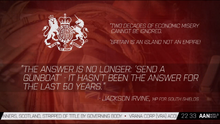
Prime Minister Ramsden's attempt to renew the British Army's mandate for continuing operations on Altis is soundly defeated in Parliament
| « | Two decades of economic misery simply cannot be ignored. Britain is an island, not an empire. The answer is no longer 'send a gunboat' - it hasn't been the answer for the last fifty years! Jackson Irvine, MP for South Shields
|
» |
Though not physically present during the events of The East Wind, conventional British forces were a component of the U.S.-led Task Force Aegis. They were initially assigned to peacekeeping duties alongside a contingent of troops from the U.S. Army's 7th Infantry Division on the Republic of Altis and Stratis.
However, an extension to their mandate was denied and eventually expired on its own following a parliamentary vote that defeated the government's motion led by the incumbent Prime Minister, Nicholas Ramsden. With growing civil unrest, a battered and stagnant economy, and the nation still in the grips of a two decade-long depression, the British military can barely afford to maintain operations on its home soil; let alone on foreign shores.
| « | The Brits are broke, man. Everyone knows it. They can't even afford to defend their pointless little islands any more. Why d'you think we're shipping out? We did our time. We kept our peace. Now we get to go play with the big boys in the Pacific. Soldiers from TF Aegis comment on the UK military's inability to deploy on peacekeeping missions
|
» |
They are mentioned on several news broadcasts as having been pulled out months prior to the breakout of hostilities between the Altis Armed Forces and the remaining American peacekeepers on Stratis.
Events of First Contact (2039)

UKSF in training exercises with NATO partners.
A moderately-sized contingent of British special operations and regular Army forces took part in "Exercise Electron-39", a joint training operation held once every two years in Livonia's Nadbór region.
They were a part of the 25,000 man force which consisted of troops from both the United States and Livonia.
Alongside their American compatriots, the exercises involved British troops assuming the task of attempting to "repel" an invasion by Russian forces (with the Livonians playing the role of the aggressors).
| SPOILER ALERT |
|---|
NOTE: This section contains spoilers from ArmA 3: Contact's 'First Contact' campaign. On June 12th, 2039, a friendly fire incident involving one of the American contingent's UCAVs resulted in the deaths of several Livonian soldiers. The incident put an immediate halt to the exercise and was ultimately cancelled - with all British and U.S. troops barred from leaving the country until a full investigation into the incident could be finished. Two weeks passed but British flights were still grounded, and were not cleared by the Livonian government to leave or enter its airspace. Diplomatic tensions between the United States and Livonia soon reached boiling point as the Americans stubbornly refused to accept any liability for the incident. This eventually culminated in Electron-39's total cancellation, with all foreign NATO personnel - British included - scheduled to depart from the country in less than 48 hours. |
Equipment

Camouflage patterns used by ArmA 2-era British forces from left-to-right:
- DDPM (British Army, Takistan)
- Multi-Terrain Pattern (British Army, Takistan)
- DPM (British Army, Chernarus)
For ballistic protection, British Army troopers mostly wear the Osprey Mk2 body armour vest as well as Mk7 combat helmets as headwear. Like their American counterparts, most troopers are also issued a set of night vision goggles for use in low-visibility conditions.
Personal gear is usually camouflaged with the DPM/DDPM patterns for use in either woodland or desert environments (respectively), though the contingent in Takistan primarily utilises the newer Multi-Terrain Pattern (MTP) universal camouflage pattern.
Arsenal
Gallery
Video
External links
See also
- NATO
- United States Army
- Army of the Czech Republic
- German Bundeswehr Kommando Spezialkrafte
- Livonian Defense Force
| Factions - BLUFOR (ArmA 2) | |
|---|---|
| USMC • CDF • U.S. Army • KSK • ACR • British Army | |
| Operation Arrowhead | British Armed Forces | |





